Investigating Human Travel Patterns from an Activity Semantic Flow Perspective: A Case Study within the Fifth Ring Road in Beijing Using Taxi Trajectory Data
Abstract
:1. Introduction
- We propose a two-layer framework to effectively reveal human travel patterns based on activity semantic flows, which can describe the spatial interaction between the origin and destination and represent the activity semantics of both the origin and destination.
- We consider the geographic context and the activity dynamics, integrating an improved Word2vec model and Bayesian rules-based visiting probability ranking when constructing the latent vector representation of each pick-up point and drop-off point.
2. Study Area and Data Description
2.1. Study Area
2.2. Datasets
3. Method
3.1. Assumptions of the Proposed Method
3.2. Activity Inference
3.2.1. Pick-Up/Drop-Off Area
3.2.2. Bayesian Rules-Based Visiting Probability
3.2.3. Word2vec Model
3.2.4. Activity Semantic Annotation
- (1)
- Internal density (ID). .
- (2)
- External density (ED). .
- (3)
- Temporal Distribution of different activities.
3.3. Flow Clustering
- (1)
- Flows have the same activity semantic.
- (2)
- Flows are in spatial proximity to each other.
- (3)
- Flow lengths and directions are approximately equal.
| Algorithm 1 Spatial Clustering of Activity Semantic Flow |
| Input: —a set of activity flows; and —the size coefficient. Output: A set of spatial and activity flow clusters . Steps: 1. Build kd-tree based on the midpoint of flow. 2. Make each flow a unique cluster to initialize the original flow clusters: and , . 3. For each flow , find its flows: is calculated by the midpoint-distance between and its flow. Midpoint-distances are within the range of . Generate flow pairs , where . 4. For each flow pair , 4.1 Find the clusters and that and belong to. 4.2 If and are different clusters, 4.2.1 Compare the activity semantic, 4.2.2 If and have same activity semantic 4.2.2.1 Calculate between and . 4.2.2.2 If , merge the two clusters: and . |
4. Results
4.1. Activity Semantic Annotation Results
4.2. Comparisons of Inferred Activity Semantics from the Three Methods
4.3. Spatial Distribution of Different Travel Activities
4.4. Spatiotemporal Patterns of Activity Semantic Flows
5. Discussion and Conclusions
Author Contributions
Funding
Institutional Review Board Statement
Informed Consent Statement
Data Availability Statement
Acknowledgments
Conflicts of Interest
Appendix A
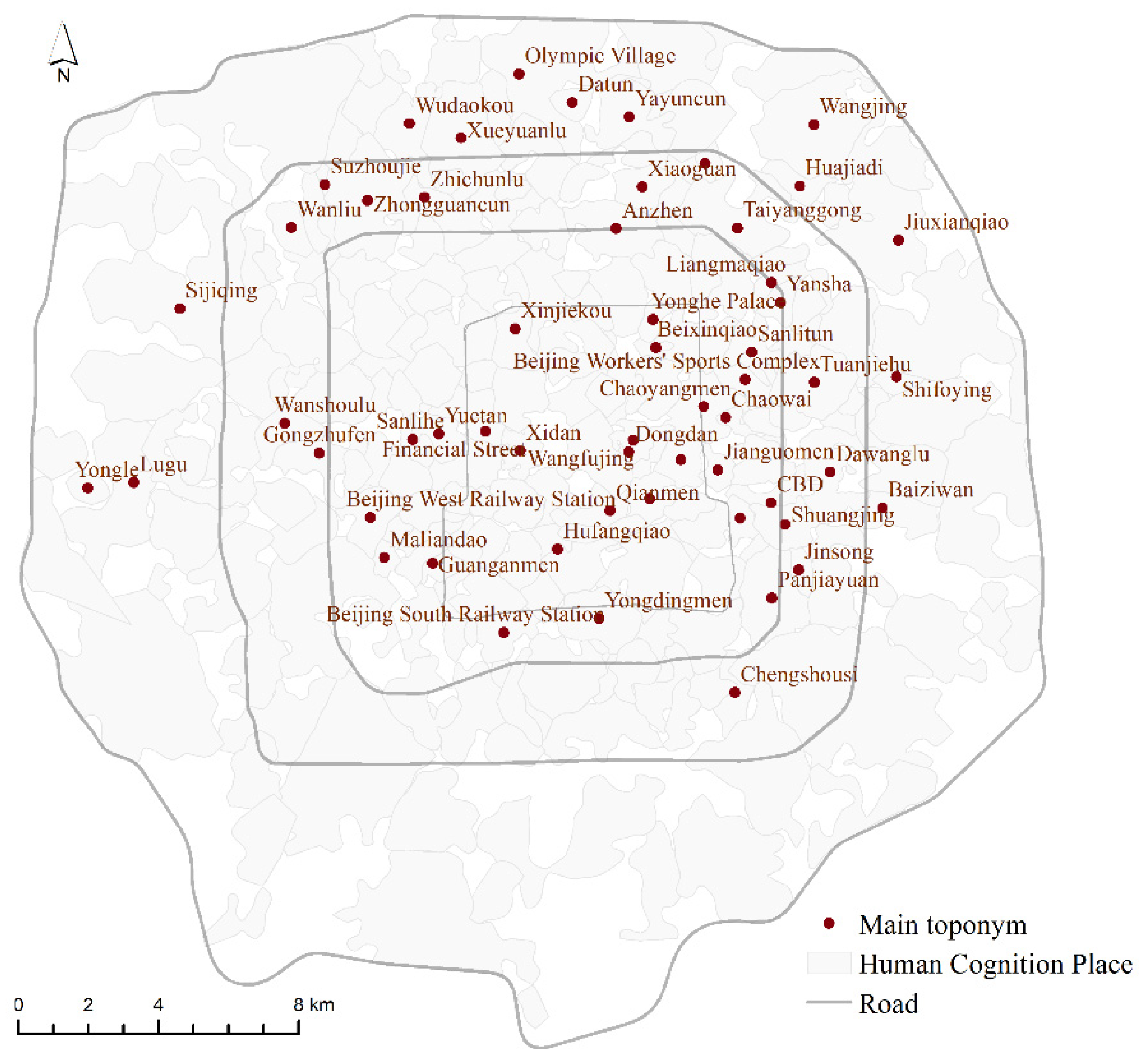
References
- Liu, Y.; Liu, X.; Gao, S.; Gong, L.; Kang, C.; Zhi, Y.; Chi, G.; Shi, L. Social Sensing: A New Approach to Understanding Our Socioeconomic Environments. Ann. Assoc. Am. Geogr. 2015, 105, 512–530. [Google Scholar] [CrossRef]
- Gong, L.; Liu, X.; Wu, L.; Liu, Y. Inferring trip purposes and uncovering travel patterns from taxi trajectory data. Cartogr. Geogr. Inf. Sci. 2016, 43, 103–114. [Google Scholar] [CrossRef]
- Gong, S.; Cartlidge, J.; Bai, R.; Yue, Y.; Li, Q.; Qiu, G. Extracting activity patterns from taxi trajectory data: A two-layer framework using spatio-temporal clustering, Bayesian probability and Monte Carlo simulation. Int. J. Geogr. Inf. Sci. 2020, 34, 1210–1234. [Google Scholar] [CrossRef] [Green Version]
- Aslam, N.S.; Zhu, D.; Cheng, T.; Ibrahim, M.R.; Zhang, Y. Semantic enrichment of secondary activities using smart card data and point of interests: A case study in London. Ann. GIS 2021, 27, 29–41. [Google Scholar] [CrossRef]
- Liu, J.; Meng, B.; Wang, J.; Chen, S.; Tian, B.; Zhi, G. Exploring the Spatiotemporal Patterns of Residents’ Daily Activities Using Text-Based Social Media Data: A Case Study of Beijing, China. ISPRS Int. J. Geo-Inf. 2021, 10, 389. [Google Scholar] [CrossRef]
- Bhat, C.R.; Koppelman, F.S. Activity-Based Modeling of Travel Demand. In Handbook of Transportation Science; Springer: Boston, MA, USA, 2006; pp. 39–65. [Google Scholar] [CrossRef]
- Beecham, R.; Wood, J.; Bowerman, A. Studying commuting behaviours using collaborative visual analytics. Comput. Environ. Urban Syst. 2014, 47, 5–15. [Google Scholar] [CrossRef]
- Wu, L.; Zhi, Y.; Sui, Z.; Liu, Y. Intra-Urban Human Mobility and Activity Transition: Evidence from Social Media Check-In Data. PLoS ONE 2014, 9, e97010. [Google Scholar] [CrossRef] [Green Version]
- Liu, Y. Revisiting several basic geographical concepts: A social sensing perspective. Acta Geogr. Sin. 2016, 71, 564–575. [Google Scholar] [CrossRef]
- Chen, C.; Liao, C.; Xie, X.; Wang, Y.; Zhao, J. Trip2Vec: A deep embedding approach for clustering and profiling taxi trip purposes. Pers. Ubiquitous Comput. 2019, 23, 53–66. [Google Scholar] [CrossRef]
- Liu, Y.; Yao, X.; Gong, Y.; Kang, C.; Shi, X.; Wang, F.; Wang, J.; Zhang, Y.; Zhao, P.; Zhu, D.; et al. Analytical methods and applications of spatial interactions in the era of big data. Acta Geogr. Sin. 2020, 75, 1523–1538. [Google Scholar] [CrossRef]
- Wang, P.; Fu, Y.; Liu, G.; Hu, W.; Aggarwal, C. Human Mobility Synchronization and Trip Purpose Detection with Mixture of Hawkes Processes. In Proceedings of the 23rd ACM SIGKDD International Conference on Knowledge Discovery and Data Mining, New York, NY, USA, 13–17 August 2017; pp. 495–503. [Google Scholar] [CrossRef]
- Kang, C.; Liu, Y.; Wu, L. Delineating intra-urban spatial connectivity patterns by travel-activities: A case study of Beijing, China. In Proceedings of the 2015 23rd International Conference on Geoinformatics, Wuhan, China, 19–21 June 2015; pp. 1–7. [Google Scholar] [CrossRef] [Green Version]
- Yue, M.; Kang, C.; Andris, C.; Qin, K.; Liu, Y.; Meng, Q. Understanding the interplay between bus, metro, and cab ridership dynamics in Shenzhen, China. Trans. GIS 2018, 22, 855–871. [Google Scholar] [CrossRef]
- Gao, Y.; Cheng, J.; Meng, H.; Liu, Y. Measuring spatio-temporal autocorrelation in time series data of collective human mobility. Geo-Spat. Inf. Sci. 2019, 22, 166–173. [Google Scholar] [CrossRef] [Green Version]
- Liu, Y.; Kang, C.; Gao, S.; Xiao, Y.; Tian, Y. Understanding intra-urban trip patterns from taxi trajectory data. J. Geogr. Syst. 2012, 14, 463–483. [Google Scholar] [CrossRef]
- Liu, X.; Kang, C.; Gong, L.; Liu, Y. Incorporating spatial interaction patterns in classifying and understanding urban land use. Int. J. Geogr. Inf. Sci. 2016, 30, 334–350. [Google Scholar] [CrossRef]
- Zheng, Y.; Liu, L.; Wang, L.; Xie, X. Discovering Regions of Different Functions in a City Using Human Mobility and POIs Jing. In Proceedings of the 18th ACM SIGKDD International Conference on Knowledge Discovery and Data Mining, Beijing, China, 12–16 August 2012; p. 247. [Google Scholar]
- Tao, H.; Wang, K.; Zhuo, L.; Li, X. Re-examining urban region and inferring regional function based on spatial–temporal interaction. Int. J. Digit. Earth 2019, 12, 293–310. [Google Scholar] [CrossRef]
- Hu, S.; Gao, S.; Wu, L.; Xu, Y.; Zhang, Z.; Cui, H.; Gong, X. Urban function classification at road segment level using taxi trajectory data: A graph convolutional neural network approach. Comput. Environ. Urban Syst. 2021, 87, 101619. [Google Scholar] [CrossRef]
- Yi, D.; Yang, J.; Liu, J.; Liu, Y.; Zhang, J. Quantitative Identification of Urban Functions with Fishers’ Exact Test and POI Data Applied in Classifying Urban Districts: A Case Study within the Sixth Ring Road in Beijing. ISPRS Int. J. Geo-Inf. 2019, 8, 555. [Google Scholar] [CrossRef] [Green Version]
- Xu, J.; Li, A.; Li, D.; Liu, Y.; Du, Y.; Pei, T.; Ma, T.; Zhou, C. Difference of urban development in China from the perspective of passenger transport around Spring Festival. Appl. Geogr. 2017, 87, 85–96. [Google Scholar] [CrossRef]
- Yang, J.; Yi, D.; Qiao, B.; Zhang, J. Spatio-Temporal Change Characteristics of Spatial-Interaction Networks: Case Study within the Sixth Ring Road of Beijing, China. ISPRS Int. J. Geo-Inf. 2019, 8, 273. [Google Scholar] [CrossRef] [Green Version]
- Liu, X.; Gong, L.; Gong, Y.; Liu, Y. Revealing travel patterns and city structure with taxi trip data. J. Transp. Geogr. 2015, 43, 78–90. [Google Scholar] [CrossRef] [Green Version]
- Xie, K.; Deng, K.; Zhou, X. From trajectories to activities: A spatio-temporal join approach. In Proceedings of the 2009 International Workshop on Location Based Social Networks, Seattle, WA, USA, 3 November 2009; pp. 25–32. [Google Scholar] [CrossRef]
- Phithakkitnukoon, S.; Horanont, T.; Di Lorenzo, G.; Shibasaki, R.; Ratti, C. Activity-Aware Map: Identifying Human Daily Activity Pattern Using Mobile Phone Data. In Proceedings of the International Workshop on Human Behavior Understanding, Istanbul, Turkey, 22 August 2010; pp. 14–25. [Google Scholar] [CrossRef] [Green Version]
- Yue, Y.; Wang, H.-D.; Hu, B.; Li, Q.-Q.; Li, Y.-G.; Yeh, A.G. Exploratory calibration of a spatial interaction model using taxi GPS trajectories. Comput. Environ. Urban Syst. 2011, 36, 140–153. [Google Scholar] [CrossRef]
- Furletti, B.; Cintia, P.; Renso, C.; Spinsanti, L. Inferring human activities from GPS tracks. In Proceedings of the 2nd ACM SIGKDD International Workshop on Urban Computing, New York, NY, USA, 11 August 2013; pp. 1–8. [Google Scholar] [CrossRef]
- Huang, L.; Li, Q.; Yue, Y. Activity identification from GPS trajectories using spatial temporal POIs’ attractiveness. In Proceedings of the 2nd ACM SIGSPATIAL International Workshop on Location Based Social Networks, San Jose, CA, USA, 2 November 2010; pp. 27–30. [Google Scholar] [CrossRef]
- Li, S.; Zhuang, C.; Tan, Z.; Gao, F.; Lai, Z.; Wu, Z. Inferring the trip purposes and uncovering spatio-temporal activity patterns from dockless shared bike dataset in Shenzhen, China. J. Transp. Geogr. 2021, 91, 102974. [Google Scholar] [CrossRef]
- Liu, X.; Huang, Q.; Gao, S.; Xia, J. Activity knowledge discovery: Detecting collective and individual activities with digital footprints and open source geographic data. Comput. Environ. Urban Syst. 2021, 85, 101551. [Google Scholar] [CrossRef]
- Yao, Z.; Fu, Y.; Liu, B.; Hu, W.; Xiong, H. Representing Urban Functions through Zone Embedding with Human Mobility Patterns. In Proceedings of the Twenty-Seventh International Joint Conference on Artificial Intelligence (IJCAI-18), Stockholm, Sweden, 13–19 July 2018; pp. 3919–3925. [Google Scholar] [CrossRef] [Green Version]
- Zhai, W.; Bai, X.; Shi, Y.; Han, Y.; Peng, Z.-R.; Gu, C. Beyond Word2vec: An approach for urban functional region extraction and identification by combining Place2vec and POIs. Comput. Environ. Urban Syst. 2019, 74, 1–12. [Google Scholar] [CrossRef]
- Yao, Y.; Li, X.; Liu, X.; Liu, P.; Liang, Z.; Zhang, J.; Mai, K. Sensing spatial distribution of urban land use by integrating points-of-interest and Google Word2Vec model. Int. J. Geogr. Inf. Sci. 2017, 31, 825–848. [Google Scholar] [CrossRef]
- Mikolov, T.; Chen, K.; Corrado, G.; Dean, J. Efficient estimation of word representations in vector space. In Proceedings of the 1st International Conference on Learning Representations, ICLR 2013, Scottsdale, AZ, USA, 2–4 May 2013. [Google Scholar]
- Tobler, W.R. A Computer Movie Simulating Urban Growth in the Detroit Region. Econ. Geogr. 1970, 46, 234–240. [Google Scholar] [CrossRef]
- Yan, B.; Janowicz, K.; Mai, G.; Gao, S. From ITDL to Place2Vec—Reasoning about Place Type Similarity and Relatedness by Learning Embeddings from Aug-mented Spatial Contexts. In Proceedings of the 25th ACM SIGSPATIAL International Conference on Advances in Geographic Information Systems, Redondo Beach, CA, USA, 7–10 November 2017; p. 35. [Google Scholar] [CrossRef]
- Żochowska, R.; Jacyna, M.; Kłos, M.; Soczówka, P. A GIS-Based Method of the Assessment of Spatial Integration of Bike-Sharing Stations. Sustainability 2021, 13, 3894. [Google Scholar] [CrossRef]
- Beijing Municipal Commission of Transport (BMCT); Beijing Transport Institute (BTI). Fifth Comprehensive Survey on Urban Traffic in Beijing; Beijing Municipal Commission of Transport: Beijing, China, 2016.
- Wang, H.; Huang, H.; Ni, X.; Zeng, W. Revealing Spatial-Temporal Characteristics and Patterns of Urban Travel: A Large-Scale Analysis and Visualization Study with Taxi GPS Data. ISPRS Int. J. Geo-Inf. 2019, 8, 257. [Google Scholar] [CrossRef] [Green Version]
- Gao, S.; Janowicz, K.; Couclelis, H. Extracting urban functional regions from points of interest and human activities on location-based social networks. Trans. GIS 2017, 21, 446–467. [Google Scholar] [CrossRef]
- Frey, B.J.; Dueck, D. Clustering by Passing Messages between Data Points. Science 2007, 315, 972–977. [Google Scholar] [CrossRef] [Green Version]
- Ramos, J.; Eden, J.; Edu, R. Using TF-IDF to Determine Word Relevance in Document Queries. In Proceedings of the First Instructional Conference on Machine Learning, Piscataway, NJ, USA, 3–8 December 2003; pp. 1133–1142. [Google Scholar]
- Liu, K.; Qiu, P.; Gao, S.; Lu, F.; Jiang, J.; Yin, L. Investigating urban metro stations as cognitive places in cities using points of interest. Cities 2020, 97, 102561. [Google Scholar] [CrossRef]
- Kang, C.; Ma, X.; Tong, D.; Liu, Y. Intra-urban human mobility patterns: An urban morphology perspective. Phys. A Stat. Mech. Its Appl. 2012, 391, 1702–1717. [Google Scholar] [CrossRef]
- Gao, S.; Wang, Y.; Gao, Y.; Liu, Y. Understanding Urban Traffic-Flow Characteristics: A Rethinking of Betweenness Centrality. Environ. Plan. B Plan. Des. 2013, 40, 135–153. [Google Scholar] [CrossRef] [Green Version]
- Liu, K.; Gao, S.; Qiu, P.; Liu, X.; Yan, B.; Lu, F. Road2Vec: Measuring Traffic Interactions in Urban Road System from Massive Travel Routes. ISPRS Int. J. Geo-Inf. 2017, 6, 321. [Google Scholar] [CrossRef] [Green Version]
- Li, A.; Huang, Y.; Axhausen, K.W. An approach to imputing destination activities for inclusion in measures of bicycle accessibility. J. Transp. Geogr. 2020, 82, 102566. [Google Scholar] [CrossRef]
- Catells, M. The Informational City: Information Technology, Economic Restructuring, and the Urban-Regional Process; Blackwell: New York, NY, USA, 1989; pp. 480–482. [Google Scholar]
- Pei, T.; Liu, Y.; Guo, S.; Shu, H.; Du, Y.; Ma, T.; Zhou, C. Principle of big geodata mining. Acta Geogr. Sin. 2019, 74, 586–598. [Google Scholar] [CrossRef]
- Batty, M. The New Science of Cities; The MIT Press: Cambridge, MA, USA; London, UK, 2013. [Google Scholar]
- Gao, X.; Liu, Y.; Yi, D.; Qin, J.; Qu, S.; Huang, Y.; Zhang, J. A Spatial Flow Clustering Method Based on the Constraint of Origin-Destination Points’ Location. IEEE Access 2020, 8, 216069–216082. [Google Scholar] [CrossRef]
- Yao, X.; Zhu, D.; Gao, Y.; Wu, L.; Zhang, P.; Liu, Y. A Stepwise Spatio-Temporal Flow Clustering Method for Discovering Mobility Trends. IEEE Access 2018, 6, 44666–44675. [Google Scholar] [CrossRef]
- McNally, M.G. The Four Step Model. UC Irvine: Center for Activity Systems Analysis. 2018. Available online: https://escholarship.org/uc/item/0r75311t (accessed on 15 December 2021).
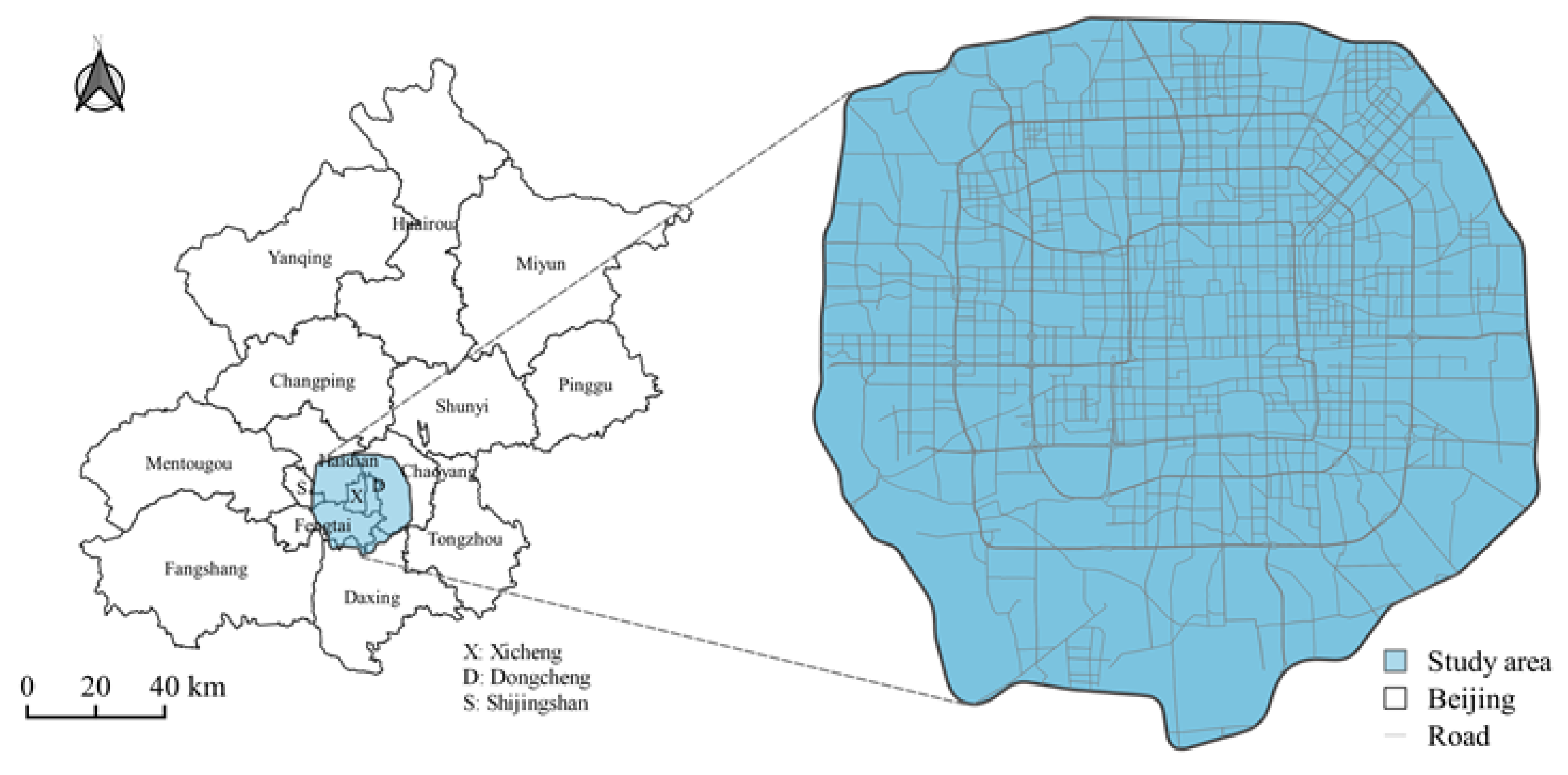
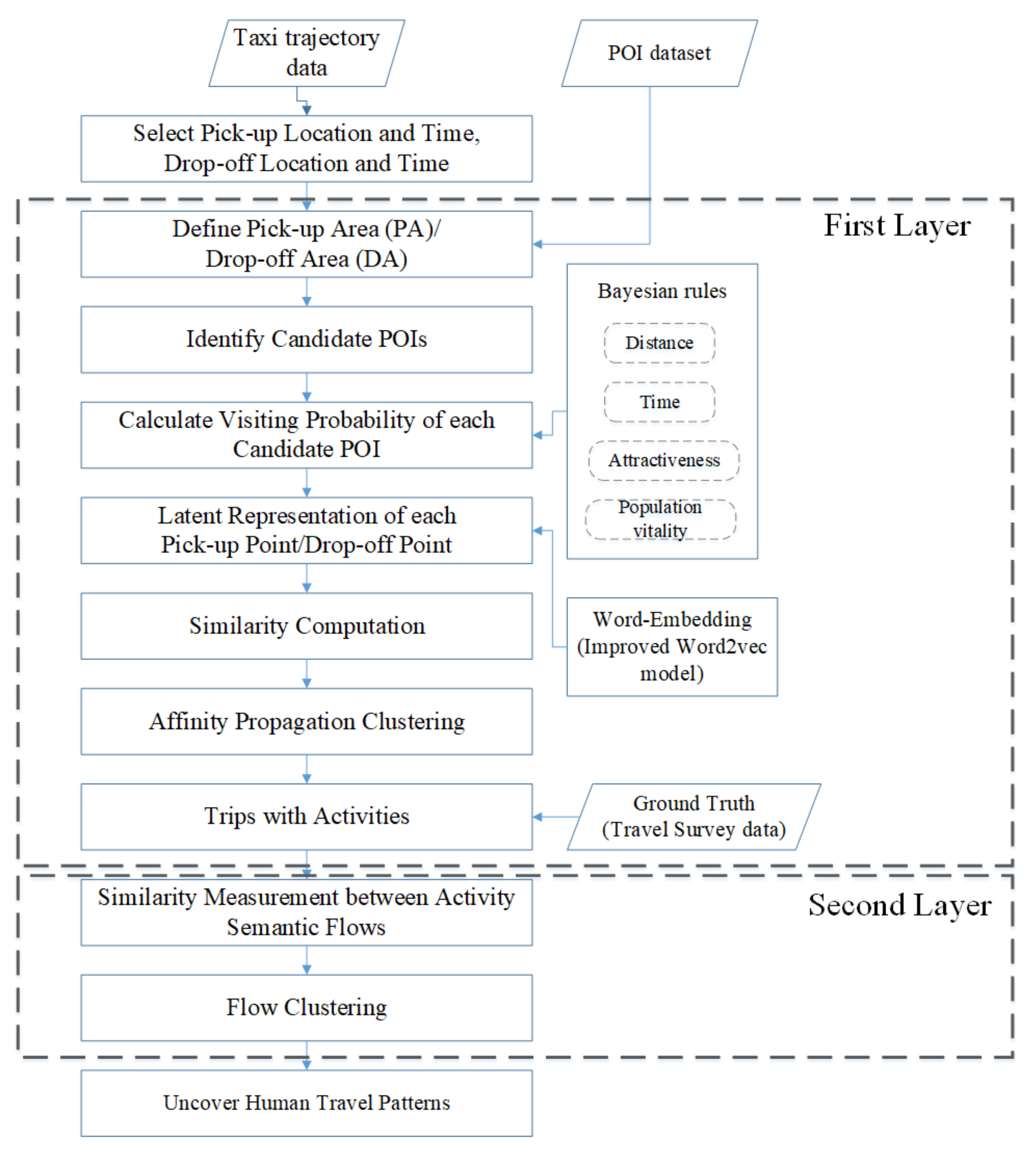
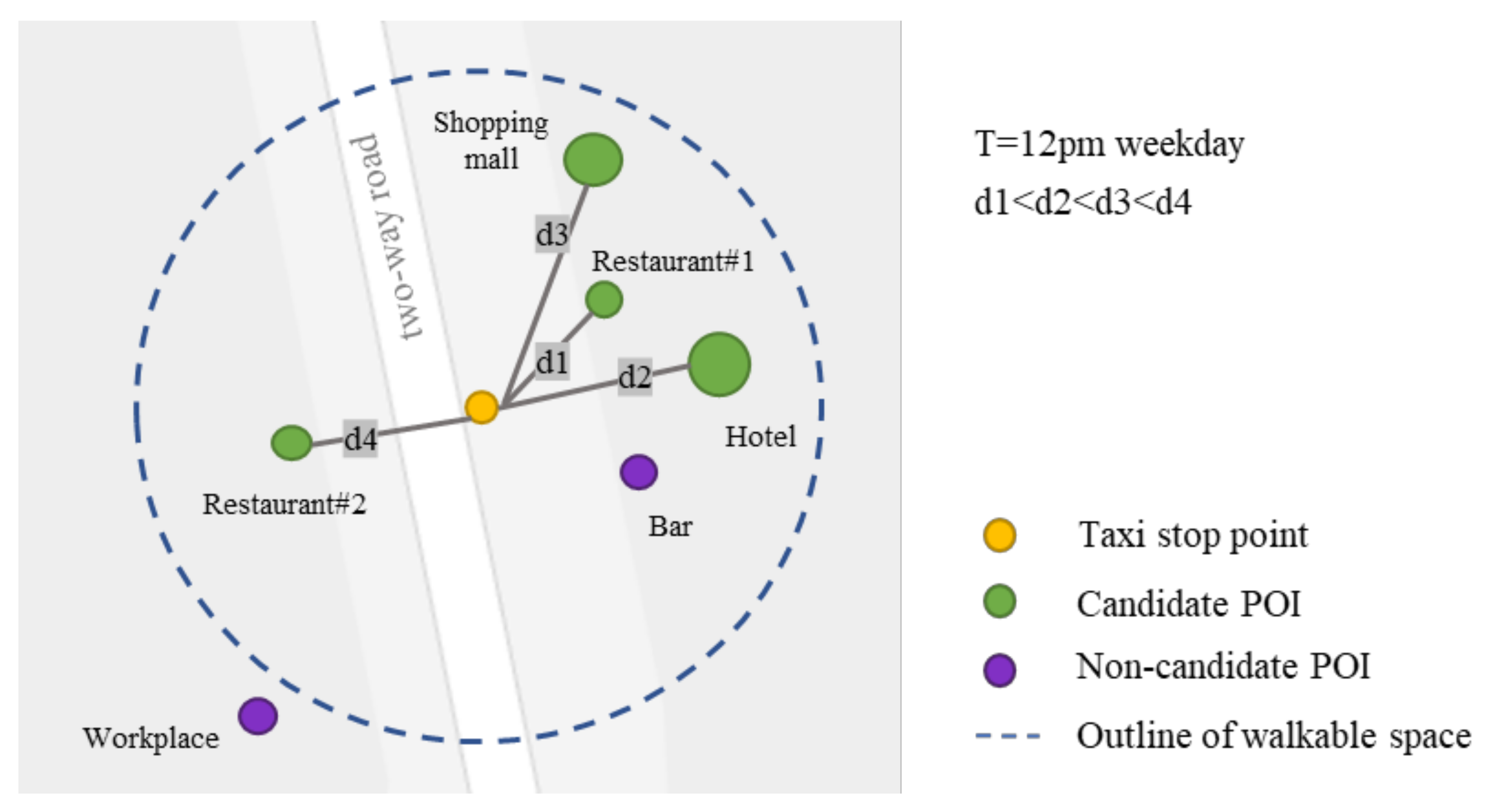
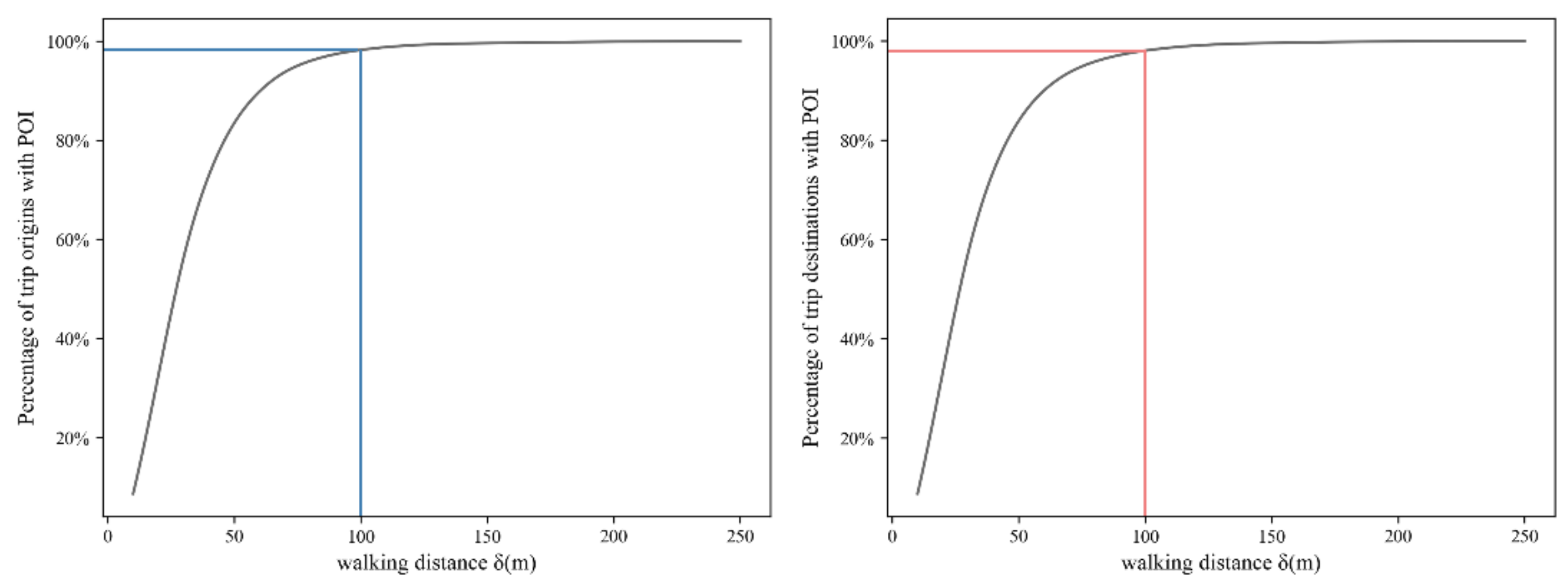

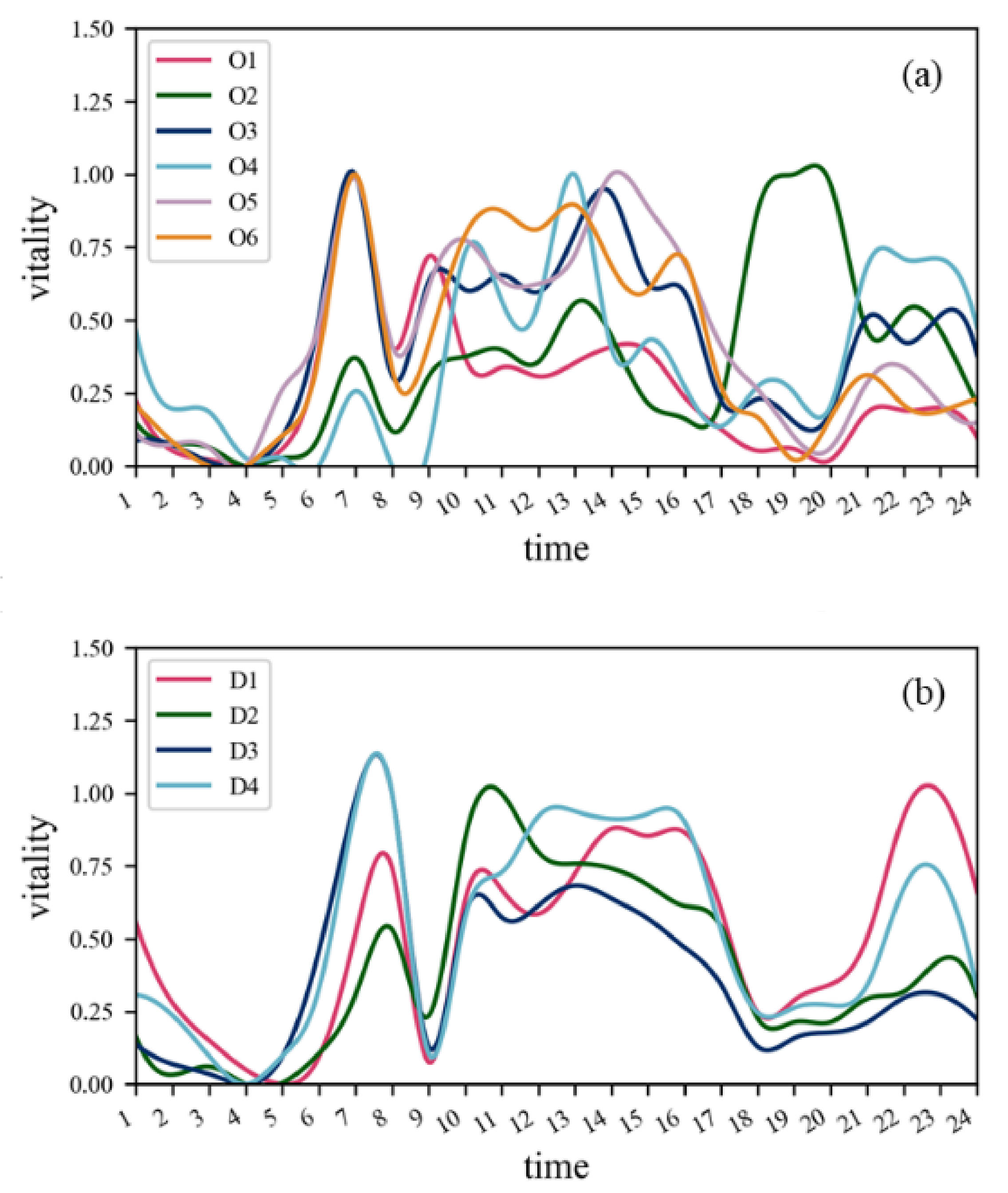
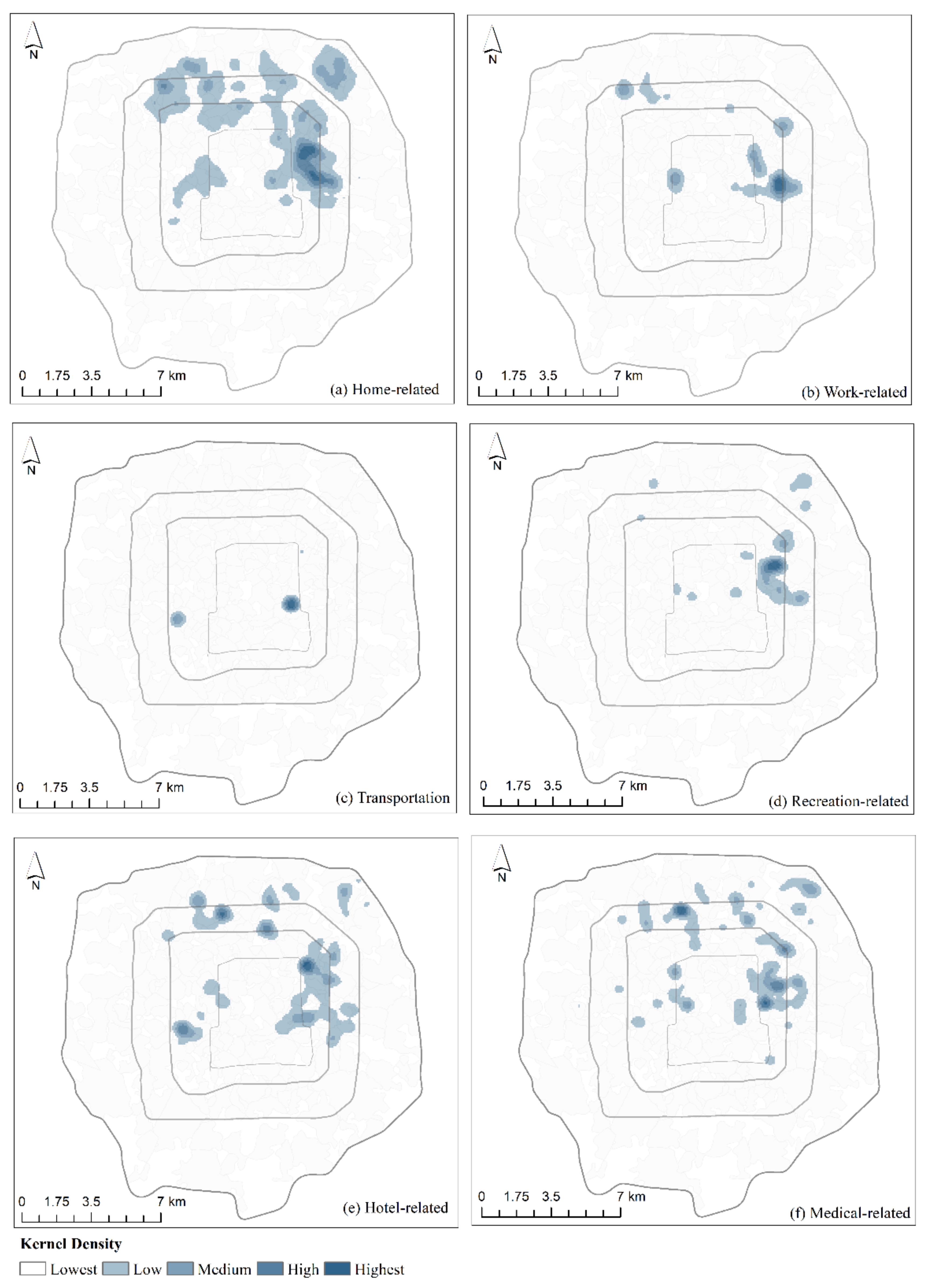
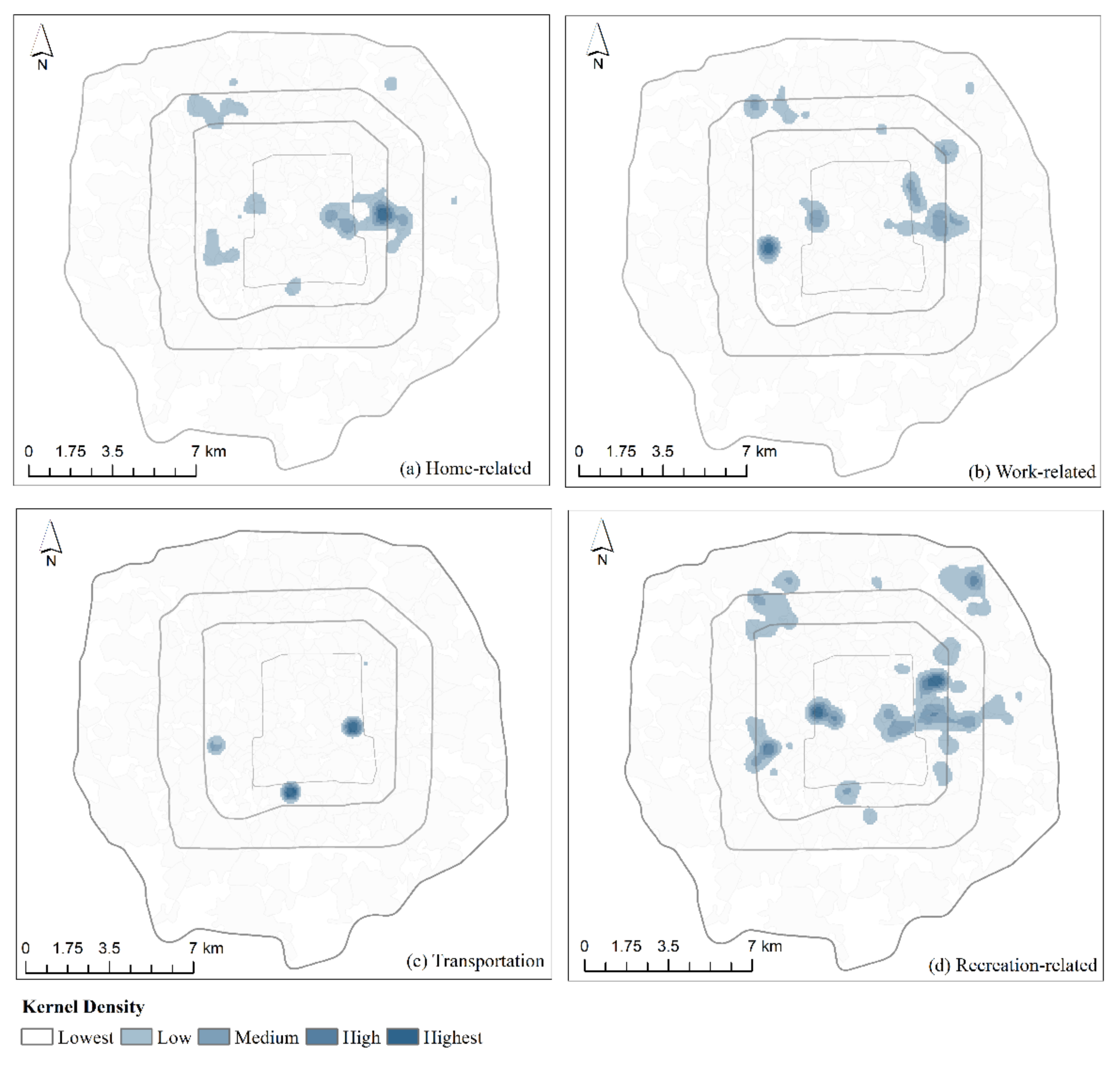
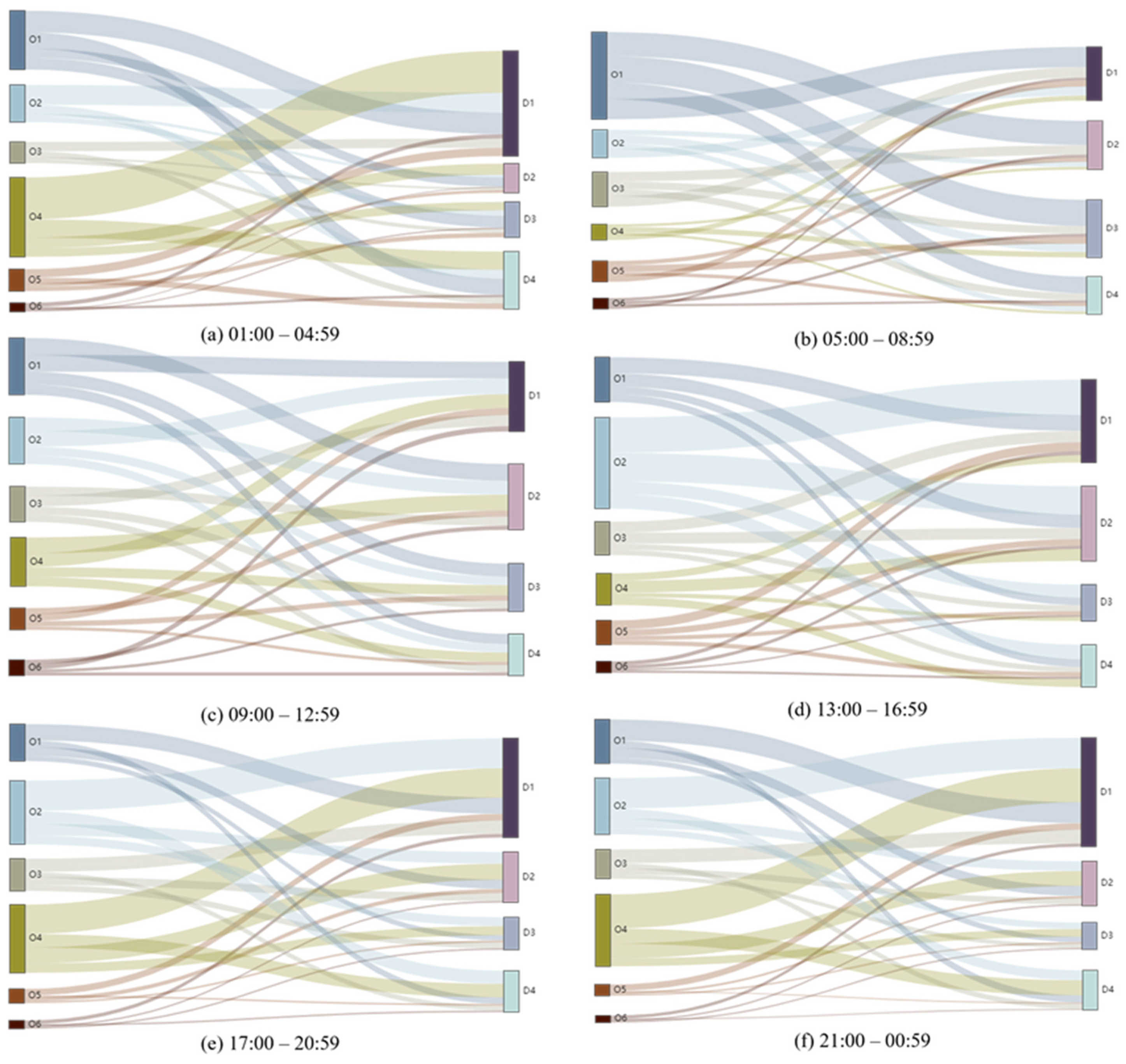

| Taxi_id | Pick-Up Location | Pick-Up Time | Drop-Off Location | Drop-Off Time | Length (km) |
|---|---|---|---|---|---|
| 00efc27613968e2891adb0c93d1a6ae6 | 116.51623, 39.91026 | 2016/5/16 11:23 | 116.37353, 39.86447 | 2016/5/16 11:47 | 13.22 |
| 51145e28389e5849dbf4dd49ed76c72d | 116.45577, 39.95000 | 2016/5/20 0:11 | 116.30730, 39.92255 | 2016/5/20 0:31 | 13.05 |
| POI Category | POI Types in Gaode Map API |
|---|---|
| Home | Residential Area |
| Work | Company, Famous Enterprise, Factory, Building, Industrial Park, Farming, Forestry, Animal Husbandry and Fishery Base |
| Transportation | Airport Related, Railway Station, Coach Station, Subway Station, Bus Station |
| Dining | Chinese Food Restaurant, Foreign Food Restaurant, Fast Food Restaurant, Leisure Food Restaurant, Coffee House, Tea House, Ice-cream Shop, Bakery, Dessert House |
| Daytime Recreation | Shopping Plaza, Sports Stadium, Golf Related, Game Center, Theatre and Cinema, Concert Hall, etc. |
| Nighttime Recreation | KTV, Pub, Disco, etc. |
| Tourist Attraction | Park and Square, Scenery Spot |
| Hotel | Hotel, Hostel |
| Schooling | School, Research Institution, Training Institution, Driving School |
| Medical Service | Hospital, Special Hospital, Clinic, Emergency Center, Disease Prevention Institution, Pharmacy, Veterinary Hospital |
| Origin | POI | ID | ED | Destination | POI | ID | ED |
|---|---|---|---|---|---|---|---|
| O1 | Dining | 0.577 | 0.252 | D1 | Dining | 0.518 | 0.39 |
| Schooling | 0.123 | 0.314 | Work | 0.185 | 0.431 | ||
| Home | 0.029 | 0.389 | Home | 0.042 | 0.991 | ||
| O2 | Work | 0.421 | 0.649 | D2 | Dining | 0.434 | 0.221 |
| Dining | 0.349 | 0.208 | Work | 0.293 | 0.463 | ||
| Daytime Recreation | 0.024 | 0.311 | Schooling | 0.117 | 0.371 | ||
| O3 | Dining | 0.465 | 0.067 | D3 | Dining | 0.465 | 0.168 |
| Transportation | 0.229 | 0.521 | Transportation | 0.455 | 0.835 | ||
| Work | 0.109 | 0.041 | Hotel | 0.028 | 0.094 | ||
| O4 | Dining | 0.725 | 0.396 | D4 | Dining | 0.668 | 0.221 |
| Nighttime Recreation | 0.033 | 0.394 | Hotel | 0.071 | 0.212 | ||
| Daytime Recreation | 0.024 | 0.286 | Daytime Recreation | 0.013 | 0.224 | ||
| O5 | Dining | 0.434 | 0.057 | ||||
| Hotel | 0.233 | 0.312 | |||||
| Nighttime Recreation | 0.023 | 0.083 | |||||
| O6 | Dining | 0.385 | 0.019 | ||||
| Medical Service | 0.214 | 0.257 | |||||
| Hotel | 0.074 | 0.039 |
| Home | Work | Transportation | Recreation | Others | |
|---|---|---|---|---|---|
| Travel Survey | 32.10% | 19.40% | 18.80% | 17.90% | 11.90% |
| Method I | 28% | 26% | 3.50% | 37.80% | 2.60% |
| Method II | 20.34% | 33.94% | 2.27% | 37.31% | 6.14% |
| Method III | 33% | 17.20% | 21.40% | 22% | 6.40% |
Publisher’s Note: MDPI stays neutral with regard to jurisdictional claims in published maps and institutional affiliations. |
© 2022 by the authors. Licensee MDPI, Basel, Switzerland. This article is an open access article distributed under the terms and conditions of the Creative Commons Attribution (CC BY) license (https://creativecommons.org/licenses/by/4.0/).
Share and Cite
Liu, Y.; Gao, X.; Yi, D.; Jiang, H.; Zhao, Y.; Xu, J.; Zhang, J. Investigating Human Travel Patterns from an Activity Semantic Flow Perspective: A Case Study within the Fifth Ring Road in Beijing Using Taxi Trajectory Data. ISPRS Int. J. Geo-Inf. 2022, 11, 140. https://doi.org/10.3390/ijgi11020140
Liu Y, Gao X, Yi D, Jiang H, Zhao Y, Xu J, Zhang J. Investigating Human Travel Patterns from an Activity Semantic Flow Perspective: A Case Study within the Fifth Ring Road in Beijing Using Taxi Trajectory Data. ISPRS International Journal of Geo-Information. 2022; 11(2):140. https://doi.org/10.3390/ijgi11020140
Chicago/Turabian StyleLiu, Yusi, Xiang Gao, Disheng Yi, Heping Jiang, Yuxin Zhao, Jun Xu, and Jing Zhang. 2022. "Investigating Human Travel Patterns from an Activity Semantic Flow Perspective: A Case Study within the Fifth Ring Road in Beijing Using Taxi Trajectory Data" ISPRS International Journal of Geo-Information 11, no. 2: 140. https://doi.org/10.3390/ijgi11020140
APA StyleLiu, Y., Gao, X., Yi, D., Jiang, H., Zhao, Y., Xu, J., & Zhang, J. (2022). Investigating Human Travel Patterns from an Activity Semantic Flow Perspective: A Case Study within the Fifth Ring Road in Beijing Using Taxi Trajectory Data. ISPRS International Journal of Geo-Information, 11(2), 140. https://doi.org/10.3390/ijgi11020140






